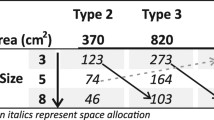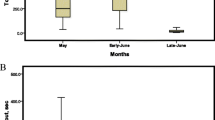Abstract
Burrowing behavior was assessed on 120 lab-reared house mice (Mus domesticus) derived from five geographic populations representing a north-south cline along the east coast of the United States. Mice were placed individually into Plexiglas containers filled with sand and peat moss, and their burrows were excavated 24 h later. Seven measures were taken and reduced by principal-components analysis to two factors for further analysis. Marked differences existed within, but not between populations, and members of full-sib families built qualitatively and quantitatively similar burrows. The lack of a geographic cline and the apparent high heritability of burrowing behavior do not lend support to its use as a major thermoregulatory adaptation.
Similar content being viewed by others
References
Adams, N., and Boice, R. (1981). Mouse (Mus) burrows: Effects of age, strain, and domestication.Anim. Learn. Behav. 9:140–144.
Berry, R. J. (1968). The ecology of an island population of the house mouse.J. Anim. Ecol. 37:445–470.
Berry, R. J., Bonner, W. N., and Peters, J. (1979). Natural selection in house mice from South Georgia (South Atlantic Ocean).J. Zool. Soc. London. 189:385–398.
Boice, R. (1977). Burrows of wild and albino rats: Effects of domestication, outdoor raising, age, experience, and maternal state.J. Comp. Physiol. Psychol. 91:649–661.
Catell, R. B. (1966). The scree test for the number of factors.Multivar. Behav. Res. 1:245–276.
Catell, R. B. (1978).The Scientific Use of Factor Analysis, Plenum, New York.
Dudek, B. C., Adams, N., Boice, R., and Abbott, M. E. (1983). Genetic influences on digging behaviors in mice (Mus musculus) in laboratory and seminatural settings.J. Comp. Physiol. Psychol. 97:249–259.
Fadem, B. H., Kraus, D. B., and Sheffet, R. H. (1986. Nest-building in gray short-tailed opossums: Temperature effects and sex differences.Physiol. Behav. 36:667–670.
Falconer, D. S. (1981).Introduction to Quantitative Genetics, 2nd ed., Longman, New York.
Flannelly, K., and Lore, R. (1977). Observations of the subterranean activity of domesticated and wild rats (Rattus norvegicus): A descriptive study.Psychol. Rec. 2:315–329.
Fleming, T. H., and Brown, G. J. (1975). An experimental analysis of seed hoarding and burrowing behavior in two species of Costa Rican heteromyid rodents.J. Mammal. 56:301–315.
Kinder, E. F. (1927). A study of the nest building activity of the albino rat.J. Exp. Zool. 57:117–161.
King, J. A., Maas, D., and Weisman, R. G. (1964). Geographic variation in nest size among species ofPeromyscus.Evolution 18:230–234.
Lore, R., and Flannelly, K. (1978). Habitat selection and burrow construction by wildRattus norvegicus in a landfill.J. Comp. Physiol. Psychol. 92:888–896.
Lynch, C. B. (1974). Environmental modification of nest-building in the White-footed Mouse,Peromyscus leucopus.Anim. Behav. 22:405–409.
Lynch, C. B. (1986). Genetic basis of cold adaptation in laboratory and wild mice. In Heller, H. C., Wang, L. C. H., and Musacchia, X. J. (eds.),Living in the Cold: Physiological and Biochemical Adaptations, Elsevier, New York.
Lynch, C. B., and Possidente, B. P. (1978). Relationship of maternal nesting to thermoregulatory nesting in house mice (Mus musculus) at warm and cold temperatures.Anim. Behav. 26:1136–1143.
Muul, I. (1968). Behavioral and physiological influences on the distribution of the flying squirrel,Glaucomys volans.Misc. Publ. Mus. Zool. Mich. 134:1–66.
Pulchalski, W., Bulova, S. J., Lynch, C. B., and Lynch, G. R. (1988). Photoperiod, temperature and melatonin effects on thermoregulatory behavior in Djungarian hamsters.Physiol. Behav. 42:173–177.
Roberts, R. C. (1967). Some evolutionary implications of behaviour.Can. J. Genet. Cytol. 9:419–435.
Shump, K. A. (1978). Ecological importance of nest construction in the hispid cotton rat (Sigmodon hispidus).Am. Midl. Nat. 89:503–509.
Webster, D. G., Williams, M. H., Owens, R. D., Geiger, V. B., and Dewsbury, D. A. (1981). Digging behavior in 12 taxa of muroid rodents.Anim. Learn. Behav. 9:173–177.
Wolfe, J. L. (1970). Experiments on nest-building behaviour inPeromyscus (Rodentia: Cricetinae).Anim. Behav. 18:613–615.
Author information
Authors and Affiliations
Additional information
This research was supported by National Science Foundation Grant BSR 8214739 to C.B.L.
Rights and permissions
About this article
Cite this article
Bouchard, P.R., Lynch, C.B. Burrowing behavior in wild house mice: Variation within and between populations. Behav Genet 19, 447–456 (1989). https://doi.org/10.1007/BF01066170
Received:
Accepted:
Issue Date:
DOI: https://doi.org/10.1007/BF01066170




